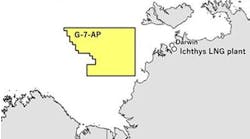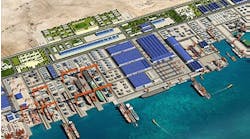Coatings designed for offshore energy infrastructure longevity, maintenance
By Anurag Raj, PPG
As the world transitions to decarbonization of energy resources, offshore wind energy remains at the forefront. The International Energy Agency (IEA) forecasts that global wind energy capacity will triple by 2026, reaching almost 120 GW, with offshore wind energy accounting for 20% of this capacity. However, this rapid expansion brings new operational challenges, echoing those faced by the offshore oil and gas industry for decades.
The offshore oil and gas industry, long accustomed to grappling with corrosion and maintenance, incurs more than $1.3 billion annually in related costs. Industry reports detail these expenses, including $589 million for surface pipeline and facilities, $463 million for downhole tubing and an additional $320 million in capex related to corrosion control. The offshore wind sector is experiencing similar challenges.
On the other hand, the industry is exploring extending the assets’ lifetime. Harsh environmental conditions in offshore energy operations—saltwater, fluctuating temperatures and high winds—make specialized protective coatings essential for safeguarding investments. These coatings, designed with marine-grade corrosion resistance and UV durability, can help extend the lifespan of offshore assets by up to 50 years. In addition to protection, coatings contribute to the circular economy by creating longer-lasting infrastructure that requires less maintenance.
Protection strategies
Asset owners and operators turn to coatings to address the specific challenges of offshore energy infrastructure longevity and maintenance. These coatings are designed to provide superior resistance to corrosion, UV radiation, chemical exposure and mechanical wear, providing a defense against the harsh conditions of marine environments.
For instance, in recent internal abrasion resistance tests, PPG’s reinforced novolac epoxy coatings outperformed styrene-free unsaturated polyester coatings by 30-40% in reducing wear and damage caused by the harsh offshore environment, thereby enhancing the durability of critical infrastructure.
Offshore oil and gas platforms require coatings that go beyond corrosion resistance. The coatings must also withstand exposure to aggressive chemicals and hydrocarbons, maintain their protective qualities in extreme temperatures and endure the physical stresses associated with deepsea operations.
Supporting the circular economy
Protective coatings directly support the circular economy by extending the life of offshore wind turbines and oil platforms. Fewer replacements can mean less extraction of raw materials, reduced energy for manufacturing and lower transportation emissions. This aligns with the circular economy, which emphasizes reuse and maximizes product lifespans. In turn, the industry conserves resources and reduces waste without compromising operational performance. According to third-party electrochemical impedance spectroscopy testing, PPG’s reinforced novolac epoxy coatings can provide a technical lifetime of 50 years or beyond, greatly extending the lifespan of offshore wind towers.
Through detailed lifecycle assessments and digital modeling, PPG’s sustainability experts quantify the emissions savings achieved by deploying specialized coatings. For example, extending the operational lifetime of offshore wind turbine blades avoids the need for premature replacements, cutting down on the embodied carbon linked to raw material extraction, transportation and fabrication. Similar benefits apply across the offshore oil and gas sector, where coatings protect critical infrastructure like platforms, pipelines and storage tanks.
Looking ahead
The offshore energy industry can preserve its assets for decades by combining technological innovation in coatings with sustainability goals. Keeping critical materials and components in productive use supports the circular economy but starts with the right protective solution.




